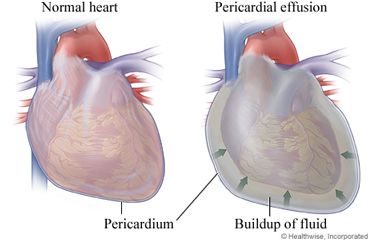
What is pericardial effusion?
Pericardial effusion is a buildup of too much fluid in the sac around your heart. This sac is called the pericardium. Normally, there is a small amount of fluid between this sac and your heart. This fluid surrounds and helps cushion your heart.
Extra fluid can be caused by many things, including pericarditis (inflammation of the sac), heart attack, surgery, kidney failure, infection, some cancers, and certain diseases such as lupus. Sometimes the cause is not known.
What happens when you have pericardial effusion?
How long it takes for the amount of fluid in your pericardium to get back to normal will depend on what caused the extra fluid and what treatment you have.
If a lot of fluid builds up, it can cause increased pressure on your heart. This pressure is called cardiac tamponade. It is an emergency that can reduce the heart's ability to pump blood.
In some people, pericardial effusion comes back and must be treated again.
What are the symptoms?
Symptoms depend on how much fluid there is and how fast the fluid builds up.
Symptoms may include:
- Chest pain.
- Trouble breathing.
Some people have no symptoms.
How is it diagnosed?
You will have an echocardiogram ("echo"). This is a test that lets your doctor see how much fluid is in your pericardium and how your heart is working. You also may have tests such as a chest X-ray, EKG, or CT scan.
Your doctor may want to take a small sample of the fluid around your heart for testing. This may help find the cause of the extra fluid.
How is it treated?
If there is only a small amount of extra fluid in your pericardium, you may not need treatment. The extra fluid may go away on its own.
Treatment depends on the cause of the extra fluid, the amount of fluid, and your symptoms. Options include:
- Medicine to treat the cause of the effusion, if the cause is known.
- Pericardiocentesis. This is a procedure that uses a needle and a tube to drain the fluid. You will get a shot of anesthetic to numb the skin and deeper tissues. You will be awake for the procedure.
- Surgery to open a section of the pericardium to drain the fluid. You may get anesthesia that makes you sleep during the surgery.
Current as of: July 31, 2024
Author: Ignite Healthwise, LLC Staff
Clinical Review Board
All Ignite Healthwise, LLC education is reviewed by a team that includes physicians, nurses, advanced practitioners, registered dieticians, and other healthcare professionals.

